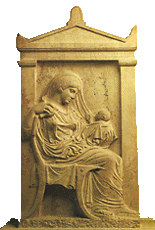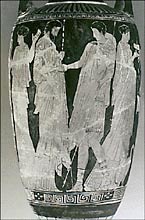 |
Relations between the members of the oikos were harmonious as a
rule. Between a mother and her children, in
particular, there were no obvious problems. Fathers and daughters
got on well, too. But rivalry between father
and son was common, especially once the latter came of age. This was because
that the father had no absolute authority, and could at any time
be challenged by his male descendants. There was also the fact
that the boy was educated and socialized outside the
home, which could create tensions if the father had
difficulty listening to new ideas such as the ones
taught by the Sophists in particular. This is why we see, in
comedy and elsewhere, the emergence of the 'generation gap'.
The attitude of siblings to one another was normally positive.
Where there might be friction was in disputes over inheritance and
in clashes between legitimate and adopted children.
|




